How To Increase Sales Online Without Spending A Dime (4 Simple Steps)
Are you getting the most sales possible from your website?
Most businesses rely on websites that aren’t optimized to sell. But you don’t have to go along with that program. Just by making a few changes to your website, you can make more money and gain a competitive edge.
Who wouldn’t want to get more mileage out of the traffic they’re already getting?
You can. Here are 4 steps how to increase sales online. None will cost you anything other than a little time and effort. And the payoffs will only compound as you drive more traffic to your site over time.
Ready? Here we go…
1. Optimize Your Web Copy
Your web copy should take the center stage in your business website.
Too many businesses obsess over every detail over their site’s design, only to neglect the most important part: the words on the page.
Choose the wrong words (or don’t put any thought into choosing them at all), and not even the coolest design in the world can save you.
This is different than selling door-to-door; you don’t get to talk to people directly. That’s why you have to take special care to make sure you get the right people’s attention and persuade them to engage with you further.
Here are a few easy ways you can upgrade your web copy:
Tweak your headlines on pages, articles, and blog posts
Did you put a lot of thought into the headlines on your business website? If not, you’re missing out on valuable attention that you could convert into more paying customers.
For each of your web pages, blog posts, and articles, take a look at your headlines and see if you can improve them.
Great headlines get noticed and get your visitors to read more about your business. And the more they read, the better your chance of persuading them to become your customers.
Check out how JumpBox increased the conversion rate on their landing page by 87%…just by changing their headline!
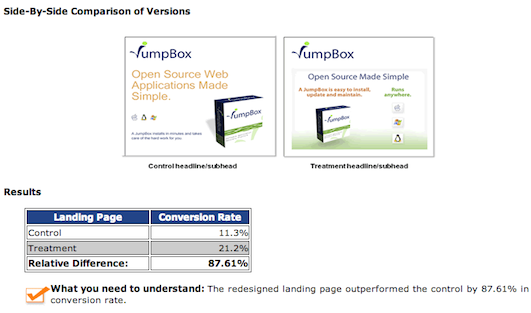
Image source: Marketing Experiments
Tweaking your headlines might be the easiest thing you can do to dramatically increase your conversions. Just remember: you don’t have to “do it all” with your headlines. All you have to do is get people to read the next line.
Guarantee your product or service
A lot of businesses don’t mention their guarantees when they discuss their product or service service. That’s one of the easiest ways to lose potential customers.

Using “trust indicators” like this guarantee seal can dramatically increase your conversions.
Just imagine how many spammy websites your average prospect is exposed to each day. They want to know your site is different. Even if the rest of your web copy seems legitimate, failing to include a guarantee might be enough to stop people from doing business with you.
You don’t have to make a huge deal about it, but if you offer a guarantee, refund, or another type of risk removal element (and you should), make sure you mention it whenever and wherever you feel it could influence your prospects’ buying decision.
Hit your prospects’ emotional hot buttons
Great web copy touches on people’s emotional hot buttons and supports the selling message with logic and statistics. This applies to even technically-minded or “sophisticated” prospects.
Why are your prospects considering doing business with you? What’s motivating them to get rid of their problem? This requires you to dig a few levels below the surface.
If you’re selling weight loss pills, for instance, your prospects want more than to “lost 15 pounds.” They want to look better naked. They want to feel confident. They want to feel good when they see themselves in the mirror. Dig to the emotional core.
Here’s a list of 6 emotions that drive people to buy:
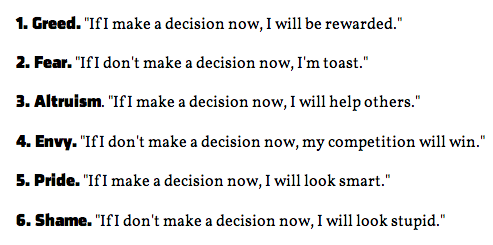
Image source: Inc. Magazine
Which of these emotions do your prospects identify with the most? How can you incorporate them in your copy? The key is striking a balance between emotion and logical appeals. Most businesses use copy that’s too logic-heavy.
Freely admit minor flaws in your product or service

Image source: Attic Paper
The days of promising people the world and having them actually believe you are long gone.
A ton of businesses refuse to admit any limitation or shortcoming about their product or service. But hiding behind an illusion of perfection doesn’t do them any favors; it makes people question how upfront you’re being and wonder if there’s something you’re trying to hide.
The more effective approach is to freely admit the minor flaws in your business.
Doing this helps you relate to your prospects on a human level; people trust you more once they see you aren’t perfect. And it actually makes the benefits you point out in your copy more persuasive:
Since the reader automatically accepts the negative admission, they become more likely to accept the implied upside. – Jeff Sexton
It seems counterintuitive, but it works. Don’t be afraid to drop the illusion that your product or service is “perfect.”
Describe your business in terms of what you can do for your prospects
Here’s a pet peeve: websites that go on and on describing their business without spelling out exactly why the prospects should care.
You can make your web copy much more persuasive by translating each feature into one or multiple benefits for your prospect. For everything you want to say about your product or service, ask yourself this question:
So what?
Pretend you’re the prospect for a second. Why should you care? It’s up to you to answer that question. Here’s an example from an American Writers & Authors Inc. article:
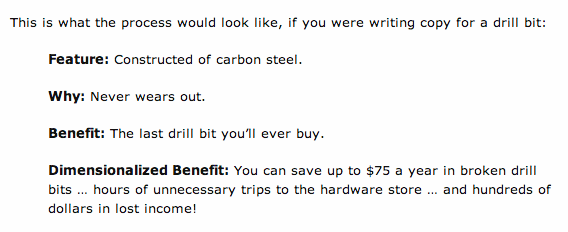
Image source: AWAI
Make the connections for your prospect. Don’t assume they’ll pick out the benefits themselves. They’re busy, and they’ve probably been to 100 other websites today.
Being clear is more important than being clever or “salesy”
Overly “salesy” or cheeky copy gives your prospects the impression of weakness… like you’re trying to cover up an inferior product or service with a lot of outrageous claims.
Present your business in the best possible light, but keep things real. Focus on being clear instead of being clever or hyping up your business to no end.
Check out how Michael Aagaard over at Content Verve increased his conversion rate by 26%:
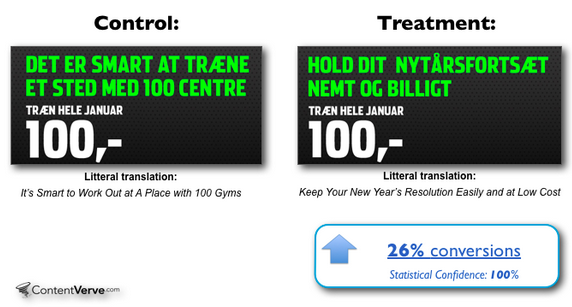
Image source: Content Verve
Was his treatment more “creative?” No… but it didn’t need to be. People trust you more when you point out the benefits as clearly as you can. And when people trust you, they buy from you.
Don’t be afraid to screen your customers
Another common mistake in business web copy is the idea that your sales message has to appeal to everyone. This weakens your copy. You might not offend anyone with that approach, but you don’t really persuade anyone either.
Focus on your ideal customers, and them alone. Don’t be afraid to turn off the “wrong” kind of prospects. Speak in terms your ideal customers understand, and talk about what’s important to them.

Doing this adds an element of authenticity that really hits home. When you stop trying to “be everything to everyone,” you become much more persuasive within your targeted group.
You don’t need to sell to everyone in the world to achieve massive financial success online. You just need to sell to your ideal customers, and sell to them well.
2. Tweak Your Website Design
Your website design has a huge impact on how effective (or ineffective) your business success will be online. A lot of businesses look at what their competitors are doing and kind of just… copy them. Or they make design decisions based on what “looks cool” instead of what sells.
Your website is your salesperson to the world. Even if you have a great product or service and the right words to sell it, people won’t stick around to hear about it if your design is confusing, shabby, or unprofessional.
Here are a few easy ways to tweak your design and make your website a more effective sales platform.
Declutter your design
Most business websites try to squeeze in too much info. Their designs are crowded and cramped. And while a lot of the information might be valuable, finding it it frustrates people to no end. Simplifying things can improve your conversions.
Just like with your web copy, your design should make it easy for your prospects to figure out: 1) what your business does; and 2) how you can help them.
Take a look at your design elements. Ask yourself what each one adds to making your sales message more persuasive. If you can’t come up with a clear answer, scrap it.
Every page should have a purpose
Each web page should have a purpose, and that purpose is to move people closer to becoming your customers.
People aren’t on your business website to waste time or be entertained. There are plenty of other websites for that.
People are on your website because they:
- Have a problem
- Want to find out more about that problem; and
- Want to see if you’re the best choice to help them fix their problem
That’s it. People’s attention spans are continuing to get shorter, so it’s critical for you to cut to the chase.
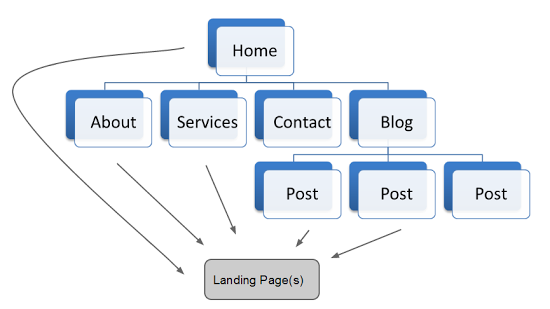
You don’t have to be boring or hide your personality, but you have to recognize there’s no time for tangents. You have their attention (for now). It’s up to you to run with it before they jump over to something else.
Use calls to action
So many businesses do a great job of capturing their prospects’ attention, offering them valuable information, and establishing their authority in their niche…
And then they just… fizzle out.
How do you close the sale online? Simple. You ask for it!
For each of your web pages, think about what do you want your visitors to do after they interact with that page. You might want them to:
- Sign up to your email list
- Leave a comment on your article or share it on social media
- Contact you for a free quote or consultation
- Sign up for a free trial (if your business has one)
- Buy your product or service

Call to action buttons
Every page where you don’t request your visitor to do something is a wasted opportunity. You don’t have to be pushy, but you need to ask your visitors to do things if you want to make more sales online.
Otherwise you’re trusting people to come back and buy from you when they “feel like it.” That leaves way too much to chance.
Create a sales funnel
There are impulse buyers out there who will buy from you right away. But most people need a bit more nurturing before they’re ready to take the leap… especially if you’re selling an expensive product or service.
You can increase your sales online by setting up your website to capture these interested but not committed types into a sales funnel.
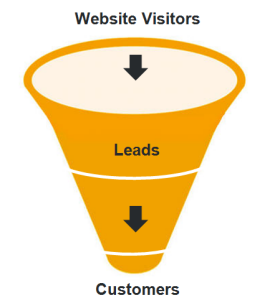
Image source: HubSpot
How you can move those cautiously interested types closer to doing business with you without scaring them away?
It could be something small, like asking them to comment on an article or sign up to your email list. Or maybe you want people to request a free consultation.
You’ll make a lot more money if you have a plan to engage people who aren’t ready to buy yet, and a website designed to deliberately move them along in the sales process.
Incorporate testimonials and social proof
Two more easy ways to bolster your influence without a lot of effort. But they’re often overlooked.
If you’ve been in business for awhile, you’ve probably developed a pool of satisfied customers. Get any nice emails lately? Ask people if you can use them on your site! WikiJob added two brief testimonials and increased their conversion rate by 34%.
It’s best for your testimonials to: 1) be specific; and 2) address common objections to buying. If your product’s expensive, for example, you could use a testimonial to reinforce what a great investment it is or how it “paid for itself five times over.”

Social proof at work..
You can add social proof by listing the number of your past customers, email subscribers, or even Facebook or Twitter followers.
Note: be careful about displaying social proof is you’re just starting out. Social proof works both ways, so if you’ve only had a few customers, you’re better off not displaying it than displaying it in low numbers.
Offer value with no strings attached
Great web copy and a clean design might get people’s attention, but you need to give most people a reason to stick around and build their relationship with you before they decide to buy.
The best way to do this is to offer your visitors valuable information. When someone has a problem, they love to read up on it and find out more. You can provide relevant, useful content as part of a content marketing strategy.
There isn’t a better way to establish your authority in your niche and build long-term, profitable relationships with people.
Rewrite your “About” page
Most businesses’ “about” pages are terrible. And that’s a shame because the “about” page is one of most heavily trafficked pages on typical websites. Not taking advantage of yours will cost you customers and sales.
People make the mistake of thinking the “about” page is really about them. It isn’t. There’s a caveat…
Your “About” page is only about YOU to the extent it shows your prospects how you can help THEM.
Your prospects aren’t interested in your life story. They’re interested in the unique things about you that make you able to help them better than any of your competitors.
For step-by-step instructions to transform your “about” page into a tool that helps you more sales, check out this great article from Founder Tips.
3. Bundle Your Products Or Service And Arrange Them In Ladders
If you offer more than one product or service, you can bundle them together and structure them into “ladders” to increase your conversions.
Arranging your different offers in a logical progression makes it easier for prospects to choose exactly what they need and buy from you without feeling overwhelmed.
Here’s how to do it:
Turn your products or services into results-oriented “bundles”
This goes back to one of the principles of writing solid web copy: frame things in terms of what’s in it for the prospect.
Too many businesses (service businesses, especially) label and describe what they can do without making it clear how those things can help their prospects.
Stay away from industry jargon and pointlessly fancy descriptions. Package your related products or services in terms of the results they’ll deliver for your customers. Here’s a great example from a company who gets this:
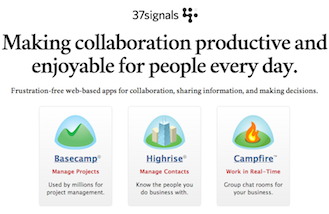
Image source: 37signals
See how easy they make it for prospects to understand what each option can do for them? Basecamp = “manage projects.” Highrise = “manage contact.” Campfire = “work in real-time.” That type of clarity is what you want to aim for, too.
Even if what you offer is technical or super complicated, you don’t have to share all the details with your prospects. Too many details can be distracting and create friction between interest and a buying decision.
Keep it to 3 or 4 options
Offering people too many choices can confuse them and and stop them from doing business with you. So it’s important to not only frame everything in terms that your prospects understand, but to not overwhelm them with the quantity of what you offer.
If you offer a laundry list of different products or services, consider how you can bundle them together into 3 or 4 choices. It might take some effort and creativity, but you’ll reap the benefits in more conversions.
If you what you do doesn’t bundle neatly into 3 or 4 categories, you can always include a “Custom” package to allow for more customization for prospects who need it.
Offer an introductory product or service
Even if you typically provide high-end, premium solutions, it can benefit you to offer an introductory product or service at a lower price point.
Doing this creates a bottom “rung” of your pricing ladder. It’s an inexpensive way for interested prospects to take your business for a test drive without making a more significant commitment.
Once you get people on the bottom rung of your price ladder, focus on overdelivering. It’s a lot easier to persuade people to invest in more expensive solutions after they’re pleasantly surprised about what you can do.
How can you offer an introductory option to your prospects?
4. Take Advantage Of Pricing Psychology
Adjusting how you price your products is another way how to increase sales online.
Your adjustments can lead to some unexpected revelations: namely, that raising your price might actually bring in more sales. Or that playing with the differences between price packages can influence how many people choose one product or service over another.
Offer upsells
Upsells are a great way to capitalize on the work you already did to get someone to buy from you. Offering an add-on, related product, or upgrade in addition to whatever the customer set out to buy can dramatically increase your sales online.
30% of people will add a last minute impulse item to their purchase if offered a relevant item that complements their purchase – Shopify
The most profitable way for you to do this depends on niche, your prospects’ disposable income, and a host of other factors. So you’ll have experiment and test until you find sweet spot for your business.
With that being said, here are a few general guidelines for how to increase sales with upells:
- Offer upsells that are related to you the customer’s original purchase
- Don’t go overboard and offer a bunch; stick to 1 or 2
- Don’t upsell at the risk of ruining the original transaction. Make the initial sale as easy as possible, and then get into the add-ons
- Upsell by pointing out which new benefits the customer will get if they buy the additional product(s); make the connections for them
Use price anchoring
That’s a fancy way of saying that people don’t value your products or services in a vacuum. They’re comparing your products or services all the time… even if it’s done at a subconscious level.
If you bundle your most premium products or services and present it along with your more reasonably-priced alternatives, you make those alternatives seem like a great deal!
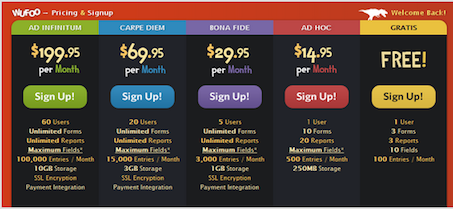
The $199.95/month price acts as the “anchor.”
It doesn’t matter if you plan to actually sell any of the high price packages. Just presenting it as an option creates the psychological anchor in your prospects’ minds. That’s all it takes to increase your conversions.
Consider raising your prices
Sounds almost too good to be true, but raising your prices might be the easiest way for you to make more sales online. You might think that raising your rates will cause fewer people to buy from you, but that’s not always the case.
A lot of it depends on your niche and how you’ve positioned yourself in it. If you present yourself as the premium solution, and you raise your prices to reflect that, you might be surprised at how many more people line up to buy from you online.
Of course, the only way to know what will work is to test. Run an experiment with your prices to figure out that sweet spot between number of customers and overall profitability.
Your Turn: Get Out There And Make Some More Sales!
Applying these strategies won’t cost you anything about than a little time and ingenuity. And they’re some of the best ways to get more money out of the hard work you’ve already done in getting a website together….
With that in mind, here’s what I want you to do next:
1. Pick at least one of the strategies from the article to implement this week.
2. Leave me a comment below and tell me which one you chose and why. If you found this article useful, please be sure to share it with your friends. Thanks.
